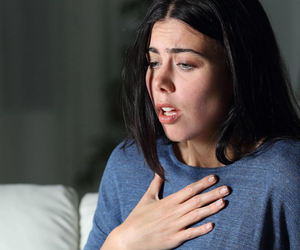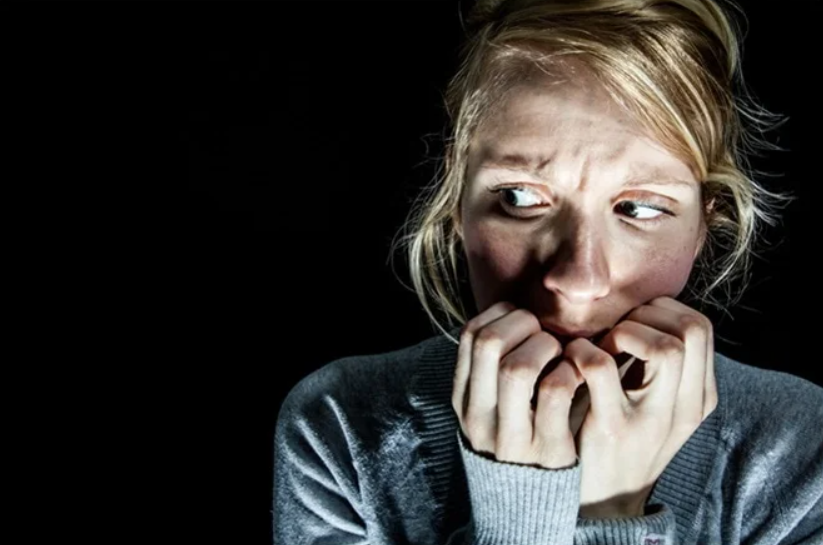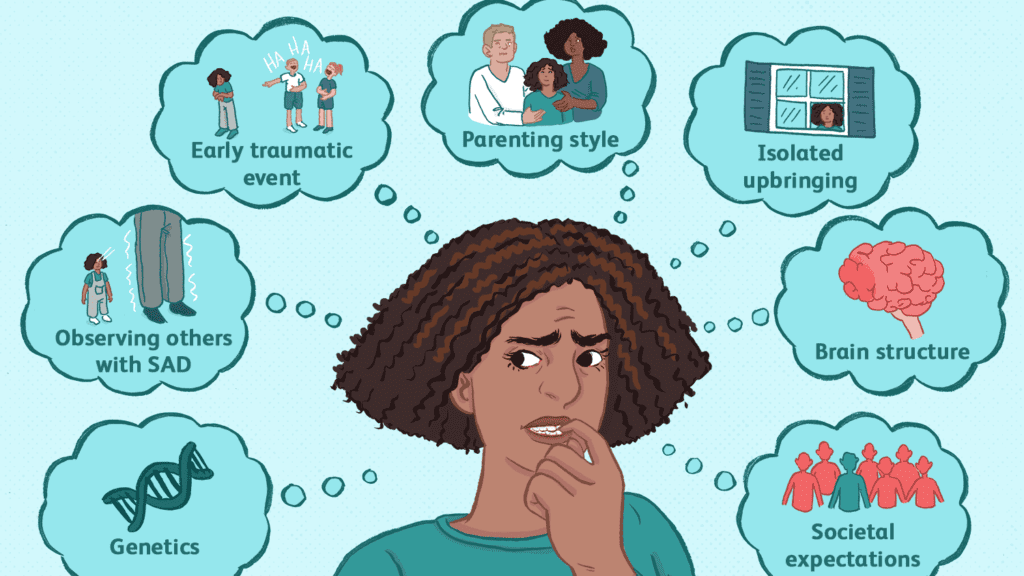
Anxiety disorders includes spectrum of diseases in which the most striking features are mental and physical symptoms of anxiety in the absence of any medical reason.
The disorders have common symptoms in their clinical picture and aetiology, but there
are also differences:
● In generalized anxiety disorders, anxiety is always continuous, but it may fluctuate in its intensity.
● In phobic anxiety disorders, anxiety is always intermittent, related to specific environment .eg Anxiety symptoms in Dark room
● In panic disorder, anxiety is always intermittent but are not related to any specific situation.
Psychological arousal
Gastrointestinal
● Dry mouth
● Difficulty in swallowing
● Epigastric discomfort I.e; nausea
● loose motions
Respiratory
Palpitations
● Tightness/Discomfort in the chest
●increase heart rate , Awareness of missed beats
Genitourinary
● urgent need of micturition
● Failure of erection
● Menstrual cycle disturbance
Muscle tension
Tremor In Hands
Headache
Body aches
Hyperventilation
Feeling of Dizziness
Tingling in the extremities (arms and legs)
Feeling of breathlessness, choking
Sleep disturbance, intermittent awakening
Insomnia
Night terror , vivid dreams
The classification of anxiety disorders;
Anxiety disorders are divided into two named subgroups:
(a) anxiety disorder spectrum which
includes panic disorder and Generalized Anxiety Disorder
B) Phobic Disorders
1.specific phobia,
2.social phobia,
3.agoraphobia
Clinical picture
The symptoms of GAD are mostly persistent .Most of the symptoms of anxiety can occur in GAD but with specific pattern which includes of following features:
● Marked Apprehension and widespread worries which are difficult to control.
● Marked Psychological arousal which may manifest in extreme irritability, poor concentration and extreme sensitivity to noise.
Autonomic overactivity is indicated by sweating,dry mouth
palpitations, dizziness and epigastric discomfort .
● Muscle tension, which may be manifested as restlessness, trembling, headache (usually bilateral and frontal or occipital) and Muscle tension of the shoulders and neck.
● Hyperventilation which may cause dizziness, tingling sensation in the extremities (arms and legs)
● Sleep disturbances ie; difficulty in falling asleep and persistent
Worrysome thoughts. Sleep is intermittent and followed by unpleasant vivid dreams. Eg; running in Fearful situations, seeing unpleasant creatures.
● Other symptoms which may include tiredness, obsessional
Symptoms and depersonalization.
FOR GAD diagnosis; symptoms must have been present for 6 months including at least 5 to 6 above mentioned symptoms
Diseases which can result in similar symptoms of Anxiety
Schizophrenia
People suffering from schizophrenia mostly complains of anxiety before other symptoms are even recognized.It is usually linked to some delusional (false) belief.
Dementia
Anxiety can be the first abnormality in a person developing Dementia .it usually results from forgetting simple things.
Substance misuse
Many people take drugs /alcohol to relieve their anxiety.
Physical illness
The following conditions are especially
important:
● In thyrotoxicosis, the patient becomes irritable and restless with tremors and tachycardia.
Physical examination may reveal signs of
Thyrotoxicosis which are an enlarged thyroid, tachycardia , and
exophthalmos. In this case , thyroid function tests
Prevalence ;
GAD can happen In any age or gender but Rates in women are
about twice as high as in men.
1.genetic factors, some patients are genetically predisposed to have anxiety.
Genes expresses more Autonomic activity and environmental influences
2.Stressful events
Early childhood abuse or neglect
Low socioeconomic status , involving repeated financial issues
3.Personality
GAD occurs prevalent in people having anxious–avoidant
personality traits .These individuals are more prone to get GAD.
Self-help and psychoeducation
self-help for anxiety disorders has to be guided by psychologist or psychiatrist. (guided self-help). Making a diary for triggering effects
Relaxation training
This includes 1)Deep Breathing Exercise 2)Progressive muscle relaxation
3)Yoga
If patient practices it regularly, it significantly decreases less severe form of anxiety
Cognitive behaviour therapy
This treatment helps by combing relaxation with changing cognition (thought process)to overcome worrying thoughts .
Medication
Anxiolytic drugs (Benzodiazepines ) are given to reduces autonomic system stimulation by relaxing muscle tension and induction of interrupted sleep
Short-term treatment.longer-acting benzodiazepines, eg;
diazepam, is used for the short-term treatment of GAD—for
example, Anxiolytic drugs are used with caution as it can cause dependence on longer run.seldom given for period above 3 weeks.
Long-term treatment.
Selective serotonin reuptake inhibitors (SSRIs) are the first line of drug for treating GAD in long tterm. Serotonin and noradrenaline reuptake inhibitors (SNRIs) like duloxetine
and venlafaxine can be given . Anticonvulsant like pregabalin can also used for treating
GAD
1. Identification and assessment: educating regarding GAD and treatment
Options
2. Low intensity interventions: self-help and guided
self-help, problem solving and relaxation techniques .
3. High-intensity psychological intervention (cognitive
behaviour therapy or applied relaxation) or a drug treatment.
4. drug and psychological regimens):
crisis services or day hospitals
1.Anxiety is not real illness .In reality it’s a major illness involving not only your mind but also bodily disturbances .
2. Everyone gets worried ,it’s normal ..
It doesn’t just affects your personal life but also declines your occupation or job performance to a level where cannot cope with worrying thoughts .
3. Too much anxiety can give you a heart attack.
It can give you panic attack mimicking heart attack but it won’t kill you.
4.Best thing to avoid anxiety is to avoid triggering situation.
In reality avoidance will increase anxiety later on.
5. Drinking alcohol or smoking Marijuana would reduce anxiety .
Infact it will initially helps but later on make things worse as it causes addiction and dependence.

The individuals having a specific phobia are extremely anxious in the presence of a specific object or situation. In this specific environment, Anticipatory anxiety is common, and the person usually wants to escape or avoid the situation. Specific phobias can be categorized further by adding the name of the stimulus (e.g. spider phobia). (E.g .height phobia)
There are five general types of specific phobias from; natural environment e.g.thunder
Around 5% of adults are found to have a fear of dental treatment. These fears can be so severe that all dental treatment is altogether avoided and caries develops. Half of dental patients tends to delay the second followup.
Anxiety during aeroplane travel occurs frequently. They experience such intense anxiety that it becomes so difficult to travel in an aeroplane, and they avoid travelling on plane. This fear is common among pilots who have had an history of accident while flying. Desensitization treatment is provided by few airlines. Virtual reality has been used to have imagined exposure. Good results have been reported.
In this phobia, even the sight of blood or of an traumatic injury results in anxiety. In this phobia autonomic response differs from that in other phobic disorders. The initial tachycardia is followed by a vasovagal response, which results in bradycardia, pallor, dizziness, and sometimes even fainting. These people can not work in hospital environments.
People fear they will choke when attempting to swallow.it has been found that have an exaggerated gag reflex The onset occurs either in
Childhood or in adulthood.
The individuals having a specific phobia are extremely anxious in the presence of a specific object or situation. In this specific environment, Anticipatory anxiety is common, and the person usually wants to escape or avoid the situation. Specific phobias can be categorized further by adding the name of the stimulus (e.g. spider phobia). (E.g .height phobia)
There are five general types of specific phobias from; natural environment e.g.thunder
People with this phobia have repeated fearful thoughts that they might have a venereal disease,cancer or some other serious illness. These people don’t resist such thoughts unlike OCD ,where thoughts are resisted. If the person believes that they have the disease, this condition is called as hypochondriasis Epidemiology Among adults, the lifetime prevalence of specific phobias has been PREVALENCE In adults, it’s life time prevalence is
Estimated be around 7% in men and 17% in women (Kessler et al., 2005a). The age of onset of specific phobias is usually in childhood. The onset of phobias of animals mostly occurs at an average age of 7 years, blood phobia at 8 years, and most situational phobias develop in the early twenties (Öst et al., 2001).
Persistence of childhood fears
Most specific phobias occurs in adulthood are infact continuation of childhood phobias. By the early teenage most of childhood fears will have been lost but in few individuals that phobias persist .(specific phobias, social phobia,
Psychoanalytical theories
Infact phobias are not related to an external Stimulus but to an internal source of anxiety. The internal source is derived from consciousness by repression and is attached to the external object by displacement.
Conditioning theory
Many Specific phobias arise through association learning. Most of specific phobias appear to start in this way in adulthood having a highly stressful experience. For example, a phobia of snake may begin after a dangerous encounter with a snake attack. The main treatment is the exposure behaviour therapy With this phobia is significantly decreased reduced in intensity and so is the social phobia. Exposure is done during several 1-hour sessions but it can be done in a single long and intensive session .
Social phobia

In this Disorder extreme anxiety is experienced in social situations, in which person has a feeling that he is being observed by others . Socially phobic people tend to avoid such situations. If they have to attend such situation they don’t exngage themselves tol much in it. for example, they avoid making conversation, or they sit in the place where they are not prominent. Social phobia must be distinguished from shyness by its intensity and occupational impairment . Virtual-reality exposure can also be of benefit The situations in which it occurs can be in restaurants, dinner parties, board meetings, and other places where the person feels observed by other people.
Symptoms
1.Marked fear or avoidance of situations in which person is exposed to unfamiliar faces
2.Two or more symptoms of anxiety in the feared situations and at least one from shaking, and fear of vomiting or urgency of micturition or defecation
3.The fear is out of proportion to actual threat posed by social condition
4.Interferes with personal functioning or occupational
Factors ;
Genetic factors
Genetic has a role and it has been seen in relatives of patients having social phobia.The population at the risk is first-degree relatives (about fourfold
increase in incidence)
Conditioning
It usually begins as a sudden episode of anxiety in a bad experienced condition.Having encounter with snake attack , makes him fear to see any object looking like snake.
Neural mechanisms
In patients with social phobia it has been seen there is increased amygdala responses In a feared situation.
Course
Social phobia has sudden and early onset begins usually in childhood or adolescence and can persist over years
Treatment
Cognitive behaviour therapy is best psychological treatment recommended for social phobia .it involves changing the thought process of patients and linked behaviours. Drug treatment SSRIs. Treatment guidelines recommend SSRIs as first drug of choice. All of the SSRIs and also venlafaxine (an SNRI) have efficacy. Medication is continued for minimum 6 months or longer
Agoraphobia
Clinical features
Agoraphobic patients are found to be anxious when they go away from home, in crowds,or in situations that they cannot leave easily. They avoid tend to avoid such situations The anxiety symptoms are similar to those of other anxiety disorders, although two features are important:
Situations
Many situations provoke anxiety and avoidance. They happen frequently in home, crowd or enclosed spaces (include buses and trains, shops a or cinema.
Anticipatory anxiety
This is very common. In severe cases anticipatory anxiety starts hours before the person has to enter the feared situation.
Other symptoms
Depressive symptoms are also common.As a consequence of limitations to normal life caused by anxiety and avoidance, while in other Depersonalization can become severe.
Onset and course
The onset and course o differ from those of other phobic disorders.
Age of onset.
The onset occurs mostly in the early 20 Or 30’s. Typically, the first episode occurs when the person is waiting for public transport or shopping in a crowded store. Suddenly they can become extremely anxious, feeling faint, and experience palpitations. They rush away from such place and go home or hospital where they feel better.
When they have to enter the same environment, they become anxious again and make another escape in a hurry. the subsequent weeks and months, with panic attacks experienced in a growing number of places, and an increasing habit of avoidance develops. However, sometimes avoidance can occur without the development of panic attacks.
Effect on the family
The condition worsens patients become so much dependent on their family or friends for help with activities like shopping or travelling .ent.
Symptoms and Diagnosis;
patients with agoraphobia tend to have panic attacks, which can be situational or suddenly and many of them meet the criteria for panic disorder.
1. Marked persistent fear in or avoidance in at least two of
the following situations— crowds (shopping malls ,markets) enclosed spaces ,(cinema or busess
2. Significant distress is caused resulting into the avoidance or anxiety
3. Being in such situations always provokes anxiety At least one symptom of autonomic arousal plus one other anxiety symptom. The anxiety is greater than the actual danger the situation may pose.
4.The fear or avoidance causes significant distress or functional impairment
Factors causing agoraphobia
Conditioning can account for association and pairing of anxiety on an isolated experience. Personality. Agoraphobic patients are mostly as dependent. This dependency could be result of pampering or overprotection in childhood. Family influences. overprotective attitudes of family members can result into this situation
Treatment
Exposure treatment is the first of the behavioural treatments. Cognitive behaviour therapy for agoraphobia is very helpful but it requires long sessions with psychologist or psychiatrist.
Medication
Benzodiazepine are very helpful in such situations significantly level of anxiety by relaxation of muscles and slowing down autonomic activity
SSRI are drug of choice .it needs to be given for atleast 6 months.
Panic disorder
The important feature are ,
People with suffering from it tend to hyperventilate (rapid and shallow breathing)
Symptoms of a panic attack
Sudden onset of:
Palpitations i.e; feeling of heart beating fast
Feeling of Choking
Severe Chest pain
Dizziness or faintness
Depersonalization, feeling as if patients body is not real
Derealization feeling that Fear of dying of heart attack or losing control/going mad Feelings caused by
Hyperventilation
Dizziness
Extreme weakness
Faintness /Numbness
Tingling sensation in the hands, feet, and face
Precordial (Heart area) discomfort
Feeling of breathlessness
Factors;
1. Genetics; Amygdala responses are seen to be high due to expression of genes responsible for it.
2. Poor stress coping. Unable to solve personal problems.
3. Personality ..people with Anxious Avoidant traits.
TREATMENT
Psychotherapy
Relaxation techniques; Deep Breathing and progressive muscle relaxation Cognitive behaviour therapy. With medication it can be very beneficial in the longer run of treatment
Medications
Benzodiazepines
benzodiazepines control panic attacks significantly e.g. Alprazolam or bromazepam
Antidepressants
Tricyclic Antidepressants; Imipramine has been shown to be effective in Panic disorder or in others including clomipramine and lofepramine SSRIs are also beneficial but can worsen initial anxiety
Myths and FAQ
1.panaic disorder is not real illness its all in your head..In reality it’s a major illness involving not only your mind but also bodily disturbances .
2. Everyone gets panic few times,it’s normal. It doesn’t just affects your personal life but also declines your occupation or job performance to a level where cannot cope with worrying thoughts .
3. Panic attack can give you a heart attack. It can give mimic a heart attack but it won’t kill you.
4. Best thing to avoid Panic attack is to avoid triggering situation. In reality avoidance will worse thinga later on.
5. Drinking alcohol or smoking Marijuana would reduce Panic attacks frequency; Infact it will initially helps but later on make things worse as it causes addiction and dependence
Best psychiatrist in Lahore,
387-E Khayaban-e-Firdousi, near Allahu chowk, Block E Phase 1 Johar Town, Lahore, Punjab 54782
Days and Timings:
Monday 03:00pm to 10:00pm
Wednesday 03:00pm to 10:00pm
Thursday 03:00pm to 10:00pm
Friday 03:00pm to 10:00pm
Sunday 03:00pm to 10:00pm
For appointment: 0321 1439754
CENTRAL HOSPITAL, GUJRANWALA
Days and Timings:
Saturday 02:00pm to 09:30pm
For appointment:
055-4277072
055-4277073
055-4277074
ONLINE VIDEO CONSULTATION
For appointment: +92 321 1439754